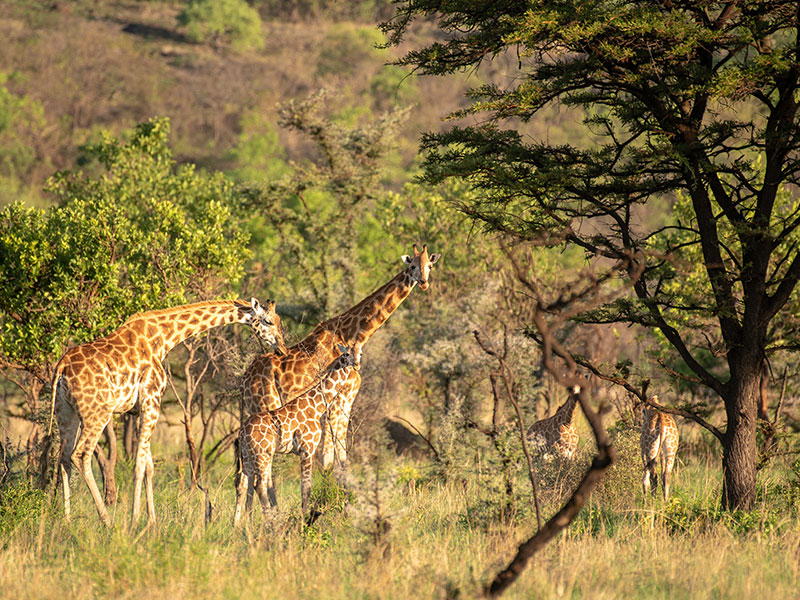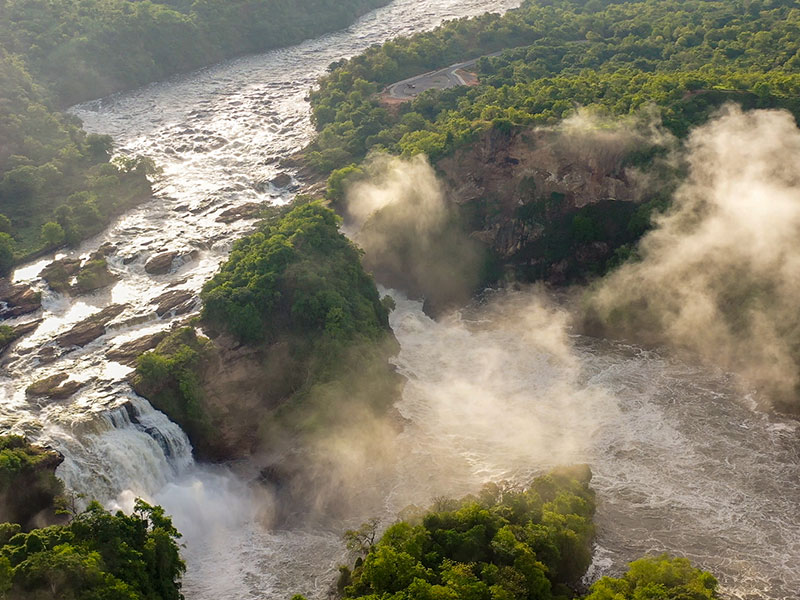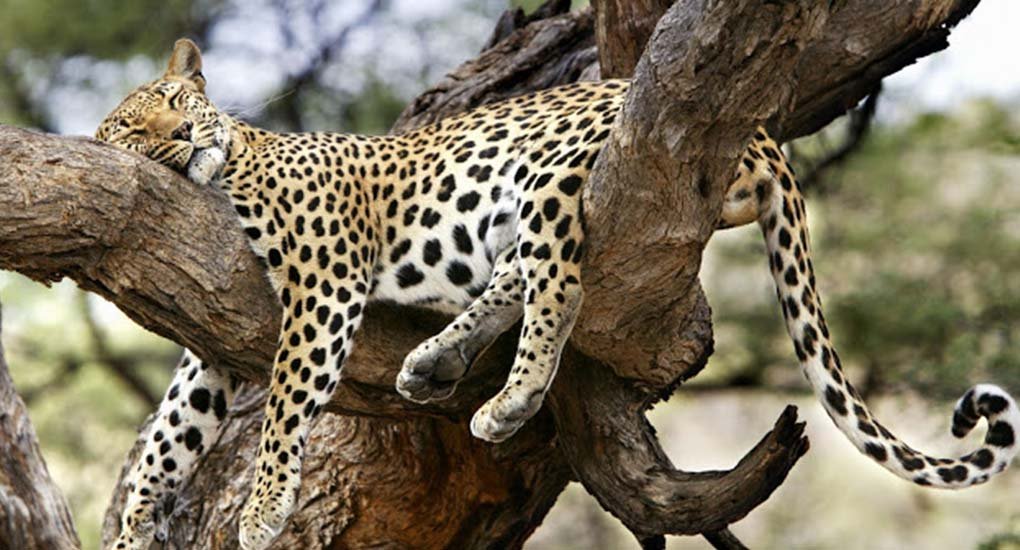Leopards in Murchison Falls National Park
Leopards in Murchison Falls – Leopards, revered for their elusive nature and striking beauty, are a captivating sight within Murchison Falls National Park. As one of the “Big Five” species found in this Ugandan wilderness, these solitary and stealthy predators are renowned for their adaptability and incredible hunting prowess. Within the park’s diverse landscapes, leopards thrive, navigating the savannahs, woodlands, and riverine habitats with remarkable agility.
Encounters with leopards in Murchison Falls National Park often rely on luck and the expertise of seasoned guides. Their camouflage and nocturnal habits make spotting them a thrilling challenge during both day and night game drives. Yet, when fortunate enough to witness these majestic creatures, visitors are treated to the sight of their distinct rosette-patterned coats, sleek movements, and often, their secretive behavior high in the tree branches where they frequently hoist their kills.
These enigmatic felines play a crucial role in the park’s ecosystem, balancing prey populations and contributing to the overall biodiversity. Their presence adds to the allure and mystique of Murchison Falls National Park, offering visitors a rare glimpse into the lives of these elusive predators amidst the stunning backdrop of Uganda’s wilderness.
Tips on spotting leopards in Murchison Falls

Spotting leopards in Uganda’s national parks, including places like Murchison Falls, Queen Elizabeth, and Kidepo Valley, can be a thrilling but challenging endeavor due to their elusive nature. Here are some tips to improve your chances of spotting these magnificent cats:
- Early Morning and Late Afternoon Game Drives: Leopards are primarily nocturnal but can also be active during the early mornings and late afternoons. Plan your game drives during these times when they might be more active and moving around.
- Expert Guides and Rangers: Enlist the help of experienced guides and rangers who are familiar with the leopard’s behavior and habitats. Their knowledge and tracking skills significantly enhance the chances of spotting these elusive cats.
- Patience and Quiet Observation: Leopards are masters of camouflage and often blend seamlessly into their surroundings. Exercise patience and keen observation skills while scanning trees, rocky outcrops, and dense vegetation where they might hide or rest.
- Focus on Water Sources and Prey Concentration: Leopards often frequent areas close to water sources, especially during the dry season when prey congregates around these areas. Focus on locations where there is a higher concentration of potential prey species.
- Use of Spotlights or Night Drives: Night drives or spotlight safaris can sometimes yield leopard sightings as they become more active after dusk. Spotlights can catch the reflection of their eyes or their movements in the darkness.
- Binoculars and Camera Equipment: Carry quality binoculars and camera equipment with good zoom capabilities to scan the landscape effectively and capture distant sightings.
- Respect Wildlife and Habitat: While searching for leopards, remember to respect the wildlife and their habitat. Maintain a safe distance and adhere to park rules and guidelines to minimize disturbance to the animals.
Remember, spotting leopards in the wild is a matter of luck and timing. Even if you don’t spot one, enjoy the overall safari experience and the multitude of other wildlife species and natural beauty that Uganda’s national parks have to offer.
Other Wildlife to see in Murchison Falls

Murchison Falls National Park boasts an incredible diversity of wildlife beyond the famed leopards, offering visitors a chance to encounter a wide array of species in their natural habitats.
- African Elephants: The park is home to a significant population of African elephants, allowing visitors ample opportunities to witness these gentle giants roaming the savannah, grazing near water sources, or taking refreshing baths.
- Lions: The park hosts both savannah and tree-climbing lions. The sight of these apex predators lounging in the grasslands or perched in trees is a thrilling experience for visitors exploring the park.
- Ugandan Kob: This antelope species, known for its striking reddish-brown coat and spiral horns, is abundant in Murchison Falls. Visitors can spot large herds grazing in the grassy plains.
- Buffaloes: Large herds of African buffalo, often seen in groups near water sources, graze across the park’s varied landscapes, showcasing their formidable presence.
- Giraffes: The park offers sightings of Rothschild’s giraffes, an endangered species known for their distinctive coat patterns and towering height as they gracefully move through the savannah.
- Hippos and Crocodiles: The Nile River, flowing through the park, is home to numerous hippos wallowing in the water and Nile crocodiles basking along the riverbanks.
- Birdlife: Murchison Falls is a birdwatcher’s paradise, with over 450 bird species. Visitors can spot various species, including the shoebill stork, African fish eagle, Goliath heron, and many colorful kingfishers and weaverbirds.
- Chimpanzees: The Budongo Forest Reserve within the park is famous for its chimpanzee population. Guided chimpanzee trekking tours offer a chance to observe these primates in their natural habitat.
These diverse wildlife sightings, ranging from large mammals to incredible birdlife and primates, make Murchison Falls National Park a treasure trove for nature enthusiasts seeking an authentic African safari experience.
Best time to go

The best time to visit Murchison Falls National Park in Uganda often depends on various factors, including weather, wildlife viewing opportunities, and personal preferences.
- Dry Season (December to February and June to September):
- Wildlife Viewing: The dry season offers excellent wildlife viewing opportunities as animals tend to gather around water sources, making them easier to spot. The vegetation also thins out, improving visibility.
- Weather: The weather is generally drier with minimal rainfall, ensuring more pleasant conditions for activities like game drives and boat safaris.
- Chimpanzee Trekking: This season is ideal for chimpanzee trekking in the Budongo Forest Reserve as the trails are more accessible.
- Wet Season (March to May and October to November):
- Lush Greenery: The wet season brings lush green landscapes and rejuvenated vegetation, offering picturesque scenery for photography and birdwatching.
- Birdlife: Birdwatchers will appreciate this time as migratory bird species arrive, and many resident birds are breeding, leading to increased bird activity.
- Fewer Tourists: The park tends to be less crowded during the wet season, offering a more serene and intimate safari experience.
Choosing the best time to visit Murchison Falls National Park depends on individual preferences. The dry season, particularly from December to February and June to September, is often favored for optimal wildlife sightings and pleasant weather conditions. However, the wet season has its unique attractions, such as lush landscapes, vibrant birdlife, and fewer tourists.
Ultimately, the choice between these seasons may depend on personal interests, tolerance for heat or rain, and the specific wildlife experiences visitors hope to encounter during their safari adventure in Murchison Falls National Park.











